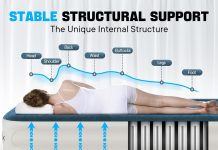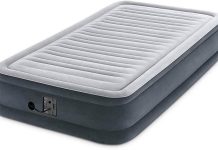Have you ever found yourself tossing and turning on your trusty air mattress, wondering if it’s time to bid farewell to your faithful sleep companion? Well, fear not! In this article, we shall uncover the telltale signs that indicate it’s time to replace your air mattress. From sagging to leaks, we’ve got you covered, ensuring that you’ll never have another deflating night’s sleep again. So, grab your pillows and blankets, and let’s embark on the journey of discovering when it’s time to bid adieu to your old, worn-out air mattress.
Review contents
Deflation Issues
Continuous Air Leakage
One of the clear signs that it’s time to replace your air mattress is if you constantly find yourself waking up to discover that it has deflated overnight. Continuous air leakage can significantly affect the quality of your sleep and leave you feeling groggy and unrested. It’s frustrating to wake up in the middle of the night only to find yourself lying on a flat mattress. If this issue persists, it’s a good indication that your air mattress has reached its limit and it’s time to invest in a new one.
Frequent Need for Re-Inflation
Another common issue with air mattresses is the need for frequent re-inflation. While it’s normal for air mattresses to lose a small amount of air over time due to temperature changes or usage, having to re-inflate it regularly suggests a larger problem. If you find yourself having to pump air into your mattress every couple of days or even every single night, it’s a sign that your air mattress is no longer able to hold air properly. This not only disrupts your sleep but also adds an unnecessary burden to your daily routine.
Uneven Deflation
While some air mattresses may deflate gradually, others may lose air unevenly. This can result in an uncomfortable sleeping experience where you find yourself sliding or sinking in certain areas of the mattress while other sections remain inflated. Uneven deflation can be a significant source of discomfort and can disrupt your sleep pattern. If you notice this issue with your air mattress, it’s time to consider replacing it with a more reliable and consistent option.
Visible Damage
Punctures or Holes
Physical damage, such as punctures or holes, is a clear sign that your air mattress needs to be replaced. Whether due to accidents, pets, or sharp objects, these kinds of damages compromise the integrity of the mattress and can result in severe deflation. Attempting to repair a punctured air mattress can often be ineffective and time-consuming. It’s best to opt for a new mattress that will provide you with a reliable and secure sleep surface.
Tears or Rips
Similar to punctures and holes, tears or rips in the material of your air mattress are signs of significant damage. These can occur over time due to wear and tear or even as a result of improper handling or storage. Once the tear or rip occurs, there is no reliable way to fix it, and it’s recommended to replace your air mattress to ensure a comfortable and uninterrupted sleep.
Seam Separation
The separation of seams in an air mattress is another visible sign of damage that warrants replacement. When the seams start to come apart, it compromises the structural integrity of the mattress and can lead to significant air leakage. This can result in an uneven sleeping surface and an overall uncomfortable experience. If you notice seam separation on your air mattress, it’s time to start shopping for a replacement that offers better durability and longevity.
Uncomfortable Sleep
Loss of Support
As air mattresses age, they may begin to lose their ability to provide adequate support for your body. This can result in discomfort and lead to restless nights. If you find yourself waking up with sore muscles or aches and pains after sleeping on your air mattress, it may be a sign that it no longer offers the support your body needs. Investing in a new mattress with improved support can significantly enhance your sleep quality and overall well-being.
Lumps or Sags
Over time, air mattresses may develop lumps or sags that can be quite uncomfortable. These uneven surfaces can cause discomfort and make it challenging to find a comfortable sleeping position. If you find yourself constantly readjusting or waking up due to uncomfortable lumps or sags, it’s time to consider replacing your mattress. A new mattress will ensure a smooth and supportive sleep surface, allowing you to wake up refreshed and pain-free.
Uneven Surface
In addition to lumps and sags, an air mattress that provides an uneven sleeping surface can also compromise your sleep quality. If you find yourself rolling or sliding towards one side of the bed, it can be frustrating and disrupt your sleep. Uneven surfaces on your air mattress are indicators that it’s time for a replacement. Look for a mattress that offers consistent support and a smooth sleeping surface to ensure a restful and comfortable night’s sleep.
Hygiene Concerns
Mold or Mildew Growth
One hygiene concern that often arises with air mattresses is the growth of mold or mildew. These are typically caused by moisture or improper storage, and they can lead to unpleasant odors and potential health hazards. If you notice any signs of mold or mildew on your air mattress, it’s crucial to replace it promptly to avoid any respiratory issues or allergies that may arise from prolonged exposure to these contaminants.
Persistent Odor
Alongside mold or mildew growth, a persistent and unpleasant odor is another signal that your air mattress is due for replacement. Over time, the accumulation of sweat, body oils, and other substances can result in a lingering smell that can be hard to eliminate. While you can try cleaning and deodorizing your mattress, if the odor persists, it’s a clear indication that it’s time for a new one. A fresh and odor-free sleep environment is essential for a restful and rejuvenating sleep experience.
Allergies or Respiratory Issues
Dust Mites Accumulation
Air mattresses, especially those used regularly, can serve as a breeding ground for dust mites. These microscopic organisms are a common allergen and can lead to various respiratory issues such as coughing, sneezing, or even asthma attacks. If you find yourself experiencing allergy-like symptoms or respiratory problems whenever you sleep on your air mattress, it’s a strong indication that it’s time for a replacement. Look for a mattress with hypoallergenic properties that can help alleviate these issues and provide a healthier sleep environment.
Irritation or Breathing Problems
Similarly, if you experience skin irritation or difficulty breathing when using your air mattress, it may be a result of the materials used in its construction or the presence of irritants. Some individuals may be more sensitive to certain materials found in air mattresses, leading to adverse reactions. Experiencing persistent irritation or breathing problems is a clear sign that it’s time to switch to a mattress that better caters to your specific needs and does not compromise your health and well-being.
Age and Usage
Longevity Expectations
Although the lifespan of an air mattress can vary depending on the quality and usage, most air mattresses have a limited lifespan. If you’ve had your air mattress for an extended period, consider the manufacturer’s designated lifespan and compare it to your own usage. If your mattress has exceeded its expected lifespan, it’s highly likely that it’s time to replace it. Continuing to use an air mattress past its recommended lifespan can lead to various issues and compromise the quality of your sleep.
Frequency of Use
The frequency of use is also an essential factor to consider when determining if it’s time to replace your air mattress. If you use your air mattress regularly or even as your primary bed, it undergoes more wear and tear compared to occasional use. Regular usage can accelerate the deterioration of the mattress and result in a shorter lifespan. If you notice significant signs of wear, loss of comfort, or any other issues with your heavily used air mattress, it’s advisable to invest in a new one to ensure a better sleeping experience.
Loss of Structural Integrity
Bulging or Swollen Sections
As air mattresses age, the seams and materials may start to deteriorate, leading to bulging or swollen sections. These areas can cause discomfort and may compromise the structural integrity of the mattress. If you find that your air mattress has prominent bulges or swollen areas, it’s time to replace it. Continuing to sleep on a mattress with compromised structural integrity can increase the risk of further damage and potential harm to your sleeping posture and overall comfort.
Sagging Edges
Sagging edges are another indication that an air mattress has lost its structural integrity. If you find that the edges of your mattress sink significantly when you sit or lie on them, it’s a clear sign that the mattress is no longer reliable or supportive. In addition to causing discomfort, sagging edges can increase the risk of falls or accidents, especially if the mattress is used on an elevated surface. To ensure your safety and optimal comfort, it’s necessary to replace an air mattress that exhibits sagging edges.
Noise and Disturbance
Squeaking or Creaking Sounds
Air mattresses that squeak or creak with every movement can be incredibly disruptive to a peaceful sleep environment. These noises can wake you up during the night or disturb your partner, leading to a restless sleep for both of you. If your air mattress has become noisy, no matter how slight the noise may be, it’s an indication that its internal components or materials are deteriorating. For a quiet and uninterrupted sleep, it’s time to seek a replacement that offers improved noise reduction features.
Excessive Motion Transfer
Air mattresses are known for their ability to provide personalized firmness adjustments. However, over time, they may lose this feature, leading to excessive motion transfer. Experiencing excessive motion transfer means that any movement made by you or your partner is felt throughout the entire mattress. This can be troublesome if you or your partner are restless sleepers, as it can result in constant disturbance throughout the night. If you find yourself unable to sleep peacefully due to excessive motion transfer, it’s time to find a mattress that minimizes this issue for a more restful sleep.
Decreased Insulation
Feeling Cold or Hot
Air mattresses rely on the trapped air within them to provide insulation and regulate temperature. If you find yourself feeling excessively hot or cold while using your air mattress, it’s an indication that its insulation capability has decreased. This can be quite uncomfortable, especially during extreme weather conditions. To ensure a comfortable and temperature-regulated sleep environment, it’s crucial to replace your air mattress with one that offers enhanced insulation properties.
Inefficiency in Temperature Regulation
In addition to feeling hot or cold, an air mattress that fails to regulate temperature efficiently can lead to an uncomfortable sleep experience. If you constantly find yourself tossing and turning, trying to find the optimal sleeping temperature, it may be a sign that your air mattress is no longer able to provide efficient temperature control. Upgrading to a mattress that is specifically designed to regulate temperature will help ensure a more comfortable and restful sleep throughout the night.
Changed Comfort Preferences
Desire for Firmer or Softer Surface
As our bodies change over time, so can our preferences when it comes to mattress firmness. If you find yourself desiring a firmer or softer sleep surface than your current air mattress provides, it may be time to look for a replacement. Catering to your comfort preferences is essential for a restful sleep, and selecting a mattress that offers customizable firmness options will ensure that you can find your ideal comfort level. Don’t compromise on comfort; instead, invest in a mattress that aligns with your current needs and preferences.
In conclusion, there are various signs that indicate it’s time to replace an air mattress. From deflation issues and visible damage to uncomfortable sleep and hygiene concerns, these indicators highlight the importance of investing in a new mattress for a better sleep experience. Whether it’s continuous air leakage, tears or rips, loss of support, or decreased insulation, paying attention to these signs will help you ensure that you have a comfortable and supportive sleep surface that promotes restful and rejuvenating sleep. Prioritize your sleep health by recognizing the signs and replacing your air mattress when needed, and enjoy better sleep for years to come.































